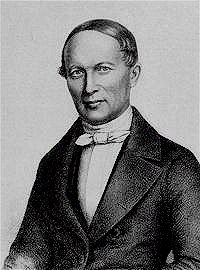Biography
Silcher’s father died when he was four years old, and his mother married Christian Heinrich Wegmann, the local school teacher. Wegmann was a faithful and loving stepfather, and Friedrich was his special darling. Friedrich was the husband of Luise Rosine Ensslin.
His schooling ended at age 14, and he wanted to become a teacher. At that time, training involved a three year apprenticeship with a master schoolteacher (Schulmeister), so Silcher became an assistant teacher in Geradstetten, Remstal.
His Schulmeister was not only a teacher, but also a renowned choirmaster, which influenced Silcher’s future development.
In 1806, when his apprenticeship was finished, Silcher became assistant teacher in Fellbach, near Stuttgart.
From 1809 on, he taught school in Ludwigsburg, where he met composers Carl von Weber and Konradin Kreutzer. Both encouraged him to make music his profession.
While in Ludwigsburg, Silcher also came into contact with the ideas of Swiss teacher Heinrich Pestalozzi. Pestalozzi advocated universal education, and using music and singing as educational tools.
In Switzerland, Hans Nägeli tried to put Pestalozzi’s ideas into action: he founded numerous choral societies, mainly male (Männergesangverein). Nägeli’s ideas greatly influenced Silcher, and the two corresponded and visited each other frequently.
Silcher highly admired Nägeli, and his letters referred to him as My dearest friend and patron.
(Once he wrote to Nägeli that Nägeli was a hero and knight of singing, and he, Silcher, was his squire.)
In 1815, Silcher moved to Stuttgart to become a musician and music teacher. One of his mentors was composer Konradin Kreutzer, director of the Württemberg Court Chapel. Silcher lived with the family of piano manufacturer Schiedmayer.
In 1817, Silcher became Music Director at the University of Tübingen, where he stayed the rest of his life. In Tübingen, Silcher founded the Akademische Liedertafel (University Singing Society) in 1829, and was its president for over 30 years.
In 1852, the University made him Doctor Philosophiae honoris causa, highest of his many honors.
To give newly formed choral societies something to sing, Silcher collected, composed and edited hundreds of folk songs, tunes, and hymns, and wrote settings and arrangements for choir and home singing.
One of the best known, by Silcher himself, was Ich weiß nicht, was soll es bedeuten, the Loreley song (words by Heinrich Heine, 1823). Silcher published the melody in 1838, but may have written it somewhat earlier.
He was also a pioneer in rediscovering sacred music by 16th and 17th Century composers such as Hassler, Palestrina, Praetorius, and Bach.
Works
- Vierstimmige Hymnen und Choralgesänge (Hymns for Four Voices), 1825 & 1828
- A Collection of 62 hymns for two or three voices (
arranged for school, church and home use
)
- Geschichte des evangelischen Kirchengesangs (History of Protestant Church Singing), 1846


